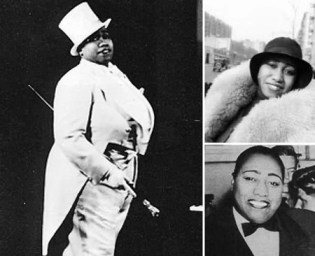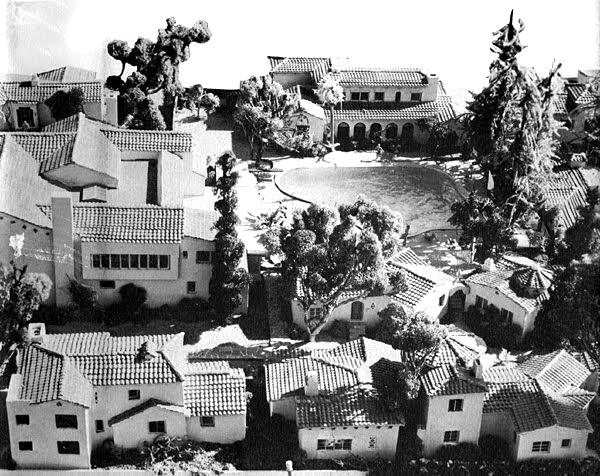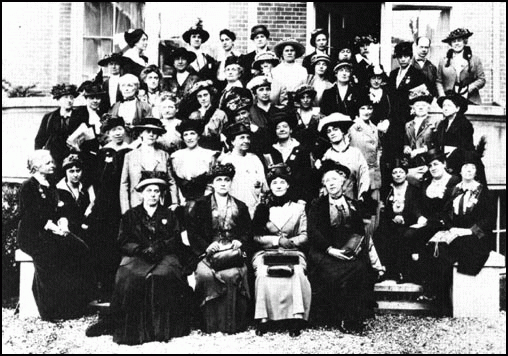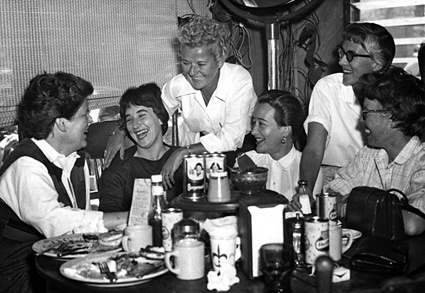If you happen to find a Time Machine and have a free afternoon and are interested in making new lesbian friends, we’ve gathered some places you should check out. I mean, even though we’re not actively being stoned to death in a public square and sent to jail for wearing a tie in public these days, it can still be difficult to meet other queer girls in this weirdo world we live in, so why not just like, go back in time and see what’s going on? You know?
10 Great Places to Meet Other Lady-Loving Ladies if You Have a Time Machine
1. Mona’s 440 – San Francisco, CA – 1930s/40s

Mona’s, San Francisco’s first lesbian nightclub, opened in 1934 on Union Street, later moving to Columbus Avenue. Mona Sargent and her husband had an idea for a bohemian artsy kind of place for writers, with sawdust-covered floors and singing waitresses. It was a hit! The singing waitresses eventually evolved into a cross-dressing drag show which was perfect for the reputation it had in local paper “San Francisco Life,” which ran racy ads for the place. Mona would take out quarter pages in SFL to advertise the male impersonators she hired out of Los Angeles and New York, and SFL referred to Mona’s as “bohemian” which was often code for “QUEER.” “Where to Sin in San Francisco” wrote about Mona’s that “the little girl waitresses look like boys. The little-girls-who-sing-sweet-songs look like boys. And many of the little girl customers look like boys.” Just like The Abbey! If you’re the type to care deeply about the lives of Celesbians, then Mona’s performers will have a strong appeal. It would seem the Mona’s cross-dressers were some of the world’s first Celesbians —> “Patrons speculated about their lives, journalists followed their activities, and tourists had them pose for nightclub photos.”
If you’re the type to care deeply about the lives of Celesbians, then Mona’s performers will have a strong appeal. It would seem the Mona’s cross-dressers were some of the world’s first Celesbians —> “Patrons speculated about their lives, journalists followed their activities, and tourists had them pose for nightclub photos.”
2. The Clam House – New York, NY / 1920s

At The Clam House in Harlem during The Harlem Renaissance, the legendary lesbian singer Gladys Bentley — who always wore a suit, onstage and off — was all the rage at this mega-popular uptown gay bar. She played piano, sang in a glorious growling voice and was widely appreciated for making up dirty lyrics to popular songs. A self-declared “bulldagger,” she told a reporter once that she’d married a white woman in Atlantic City. This may or may not have been true. There were a shit-ton of bars and clubs in Harlem at the time featuring bisexual and lesbian singers like Ma Rainey, Lucille Bogan and Bessie Smith. Places like The Cotton Club attracted tourists as well as a mix of straight, gay and lesbian locals.
3. Garden of Allah – West Hollywood, CA/ 1920s-30s

In 1918, hugely successful (at the time) actress Alla Nazimova purchased a home in West Hollywood and converted it into a 3.5-acre paradise with a pool (in 1928, it was converted into a 3.5-acre paradise with pool and a hotel). All the smart artsy people went there and it quickly became known as a lesbian gathering place. Allegedly Marlene Dietrich liked swimming in the pool naked!

Nazimova, who was in a “lavender marriage” with actor Charles Bryant for 13 years, had an affair in 1910 with the legendary Mercedes De Acosta (who threw plenty of her own lesbian parties) — way before The Chart got invented, Truman Capote used Mercedes De Acosta on his “International Daisy Chain” to link people together by shared sexual partners. “Mercedes was the best card to hold” in that game.
Despite not being a spectacular writer, Mecredes is still famous for her lesbian affairs with persons including Greta Garbo (who lived next door to de Acosta), Marlene Dietrich, Isadora Duncan, Tallulah Bankhead, Adele Astaire, Eva Le Gallienne, Amy Lowell and Ona Munson. Mercedes de Acosta was basically the Shane of the early 20th century.
4. The WAC/1940s

Desperate times called for desperate measures and World War II’s need for manpower caused them to open their militant arms to womenpower. To counteract the potential public assumption that the Women’s Army Corp was just an organized team of prostitutes serving Our Men in Uniform, the WAC girls were trained to seem chaste and asexual, which many lesbians preferred to how they’d been told to live their lives thus far, which was “chaste, asexual, and attractive to men.” Still, it was often dangerous to talk openly about being a lesbian, so it could sometimes take months for the Sapphics to find one another.
Being in the military enabled ladies to go out unescorted by men and the social networks that developed were intense, coded, and described by one enlisted lesbian as “hog heaven.” In the film Before Stonewall, printer Johnnie Phelps said “the battalion that I was in was probably about 97% lesbian.” After the war, many WAC women had acquired enough money to live without men, which was also awesome.
5. Smith, Vassar, Bryn Mawr, Mount Holyoke, Wellesley – Northeastern US /Late 19th & Early 20th century

“I should, I think, have committed suicide if I had to live with him. But my choice was made easy by the fact that in my generation marriage and academic career was impossible.”
– M.Carey Thomas, President of Bryn Mawr
Between 1880 and 1900, only 10 percent of American women remained single. But about 50 percent of American college women failed to tie the knot, including 57% of Smith’s graduating class of 1884. Thus “Boston Marriages” became a thing, where women who decided they’d rather have a career than marry a dude and have kids would maintain same-sex households with another educated woman after college. Not only did these shack-up situations become what we’d call “a lesbian relationship,” but they also enabled the ladies to live freely of the gendered constraints placed upon them by a potential husband. A 1929 study by Katherine B. Davis talked to 1,200 female college graduates about their sex lives and found 50% had “experienced intense emotional relations with other women” and 19.5% had “intense relationships accompanied by mutual masturbation, contact of genital organs, or other expressions recognized as sexual.” This was like a middle to middle-upper-class white girl thing, though. Rich women had more restricting family expectations, most poor women couldn’t afford college, many poor women couldn’t get by financially without a father or husband, and most women of color still lacked basic human rights, let alone a a semester in Northampton.
6. Rent Parties – New York, NY / 1920-1935

Private parties were still the safest places to meet other ladies during The Harlem Renaissance and “rent parties” were the most popular kind of private parties in which to do so. Rent Parties were huge in Harlem at the time, and some were very gay. The hosts provided bootleg liquor, dancing and jazz and charged admission (to help the resident pay their rent, which was astronomical at the time — many white landlords charged black tenants double what their white counterparts would pay). Fear-mongering local papers described lesbian-attended Rent Parties as “dangerous to the health of all concerned” because of their “combination of bad gin, jealous women and a carving knife.” (a.k.a. “dyke drama”)
7. The Hull House – Chicago, IL / 1890s-1930s
 Historian Jane Addams (the first American woman to ever win a Nobel Prize) met Ellen Starr in college and the two Special Friends opened Hull House together in Chicago so they could be together with other like-minded women and save the world.
Historian Jane Addams (the first American woman to ever win a Nobel Prize) met Ellen Starr in college and the two Special Friends opened Hull House together in Chicago so they could be together with other like-minded women and save the world.
The Hull House was “a settlement house in the midst of poverty where young, comfortably brought-up women who had spent years in study might now ‘learn of life from life itself.’” Women came to live and work at The Hull House, doing things like helping newly arrived immigrants adjust to America.
When not changing the world, there is strong evidence that they often made out with each other. Addams eventually broke up with Ellen and moved on to a wealthy woman named Mary Rozet Smith and they stayed together forever ever. Fun fact: The Jane Addams Hull House Association still exists!
8. The Daughters of Bilitis – started in San Francisco, CA, then went nationwide / 1950s-60s
 Founded in 1955 by legendary activists Del Martin and Phyllis Lyon, the homophile group began small in San Francisco, hosting three monthly functions in different member’s homes – a social, a business meeting and a discussion session for everyone to talk about their feelings. Then the DOB started publishing their own magazine, The Ladder. Every like-minded lez who got her hands on it flipped out and wanted to use the organization to meet other lesbos (sound familiar?). They’d just all gotten telephones so the sky was the limit, really. Many girls moved all the way to San Fran ’cause of what they’d read in The Ladder. Then individual chapters started forming all over the country (just like meet-up groups!). Here is one woman’s evaluation of the experience:
Founded in 1955 by legendary activists Del Martin and Phyllis Lyon, the homophile group began small in San Francisco, hosting three monthly functions in different member’s homes – a social, a business meeting and a discussion session for everyone to talk about their feelings. Then the DOB started publishing their own magazine, The Ladder. Every like-minded lez who got her hands on it flipped out and wanted to use the organization to meet other lesbos (sound familiar?). They’d just all gotten telephones so the sky was the limit, really. Many girls moved all the way to San Fran ’cause of what they’d read in The Ladder. Then individual chapters started forming all over the country (just like meet-up groups!). Here is one woman’s evaluation of the experience:
9. Ralph Martin’s – Buffalo, NY/1940s
“The biggest gay bar in the city of Buffalo” and “unquestionably the most open gay bar of the 1940s” was one of a few places where women could actually dance with each other. Same-sex dancing could make a bar lose its liquor license, but Ralph’s had a bar in front and used a large room in the back for dancing to the jukebox. It was a mixed-gender crowd — a patron recalls “we were never segregated like they are now. There was never any question about a gay guy’s bar. There was no such thing. Really! We always went to the same bars.” Its patrons are described as “primarily well-dressed women, including showgirls and strippers, who gave the bar its distinctive reputation for action,” but also like many bars of the time, most lesbian couples there followed a strict butch/femme dress code.
10. The Redhead, The If Club, The Open Door, The Sugar Shack, etc./ Los Angeles, CA (1940s-1950s)
Bars like The Gypsy Room on the Sunset Strip catered to a pretty specific socioeconomic class of lesbians, but after the war nightlife began getting a bit more diverse. Many American lesbians had come to Los Angeles for factory work during WWII, and a lot of women from Mexico and Hawaii were moving to LA in search of a more gay-friendly environment. Thus clubs for working-class women started popping up in lower-income neighborhoods and attracted a way more racially diverse clientele. The patrons at beer-and-pool table bars like The If Club, The Open Door, The Sugar Shack and Lakeshore were usually regulars. The Pink Glove charged a cover for straight people to discourage them from coming. And then there was The Redhead, which “welcomed only Mexican-American lesbians.” This one actually still exists — it was called Redz for a while and now it’s called Chuparosa. It still supports a mostly lesbian clientele (of all races, obvs).

Okay, time to get a snack and travel back in time!
References for this Post:
Odd Girls and Twilight Lovers: A History of Lesbian Life in America, by Lillian Fadermen
Gay L.A.: A History of Sexual Outlaws, Power Politics, and Lipstick Lesbians, by Lillian Faderman, Stuart Timmons
Boots of Leather, Slippers of Gold: The History of a Lesbian Community, by Elizabeth Lapovsky Kennedy and Madeline D.Davis
Out of the Past: Gay & Lesbian History from 1869 to the Present, by Neil Miller
The Lives of Lesbian Elders: Looking Back, Looking Forward, by D. Merilee Clunis, Karen I. Fredriksen-Goldsen, Pat A. Freeman and Nancy Nystrom
Wide-Open Town: A History of Queer San Francisco to 1965, by Nan Alamilla Boyd
The Lesbian Community, by Deborah Goleman Wolff
Bisexuality & The Eroticism of Everyday Life, by Marjorie Garber







